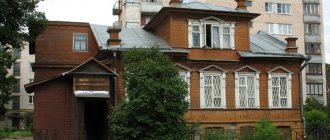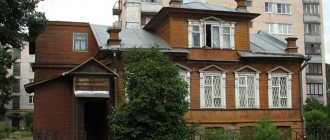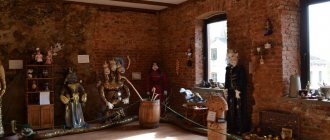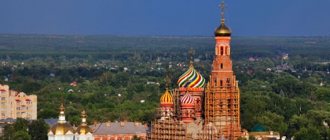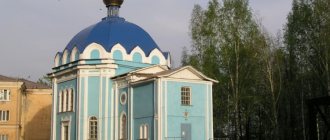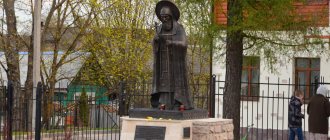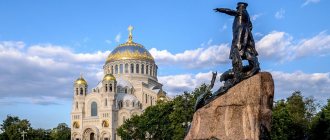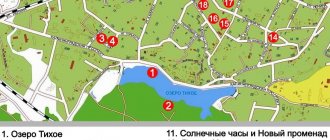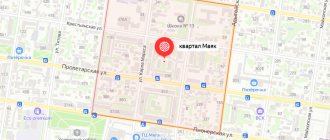Cherepovets is the largest city in the Vologda region with a variety of attractions. Cherepovets was first mentioned in the chronicle of 1362. The founding date of Cherepovets is considered to be June 4, 1777.
For 2017-2018, the population of Cherepovets was 318,856 people.
The origin of the name “Cherepovets” is not known for certain - there are numerous versions. In the 15th century this city was called “Cherepoves”. In short, the name consists of two parts - the Finno-Ugric “skull” - this is what they called the hill, the upper part of something, and the Finnish “whole” - water.
For the time being, the city was lucky: neither the Polish-Swedish intervention nor the First World War reached it. But already the Civil War of 1918-1921 and subsequent anti-religious events led to the closure of all religious buildings in the city.
In 1941, Cherepovets became a port - at that time the Rybinsk Reservoir appeared. During the Great Patriotic War, the city received evacuated residents of Leningrad. In the post-war years it became an industrial city. With the growth of industry, the population increased. Today more than 300 thousand people live in the city.
There are four districts in the city: Industrial (also called City), Zarechny, Zasheksninsky, Severny (also known as Plywood).
What is Cherepovets famous for?
Many people ask: what is this area famous for?
This city is the birthplace of the famous artist Vasily Vasilyevich Vereshchagin. Artist Vasily Vasilyevich Vereshchagin (October 14 (26), 1842 - March 31 (April 13), 1904)
This man created many battle paintings in a documentary style - for he himself participated in the battles. Not far from the Resurrection Cathedral, a monument was erected to the founders of Cherepovets - the monks Theodosius and Athanasius.
Fans of ancient cities will be interested in an article about the sights of Pskov.
The main attractions of Cherepovets
There are plenty of attractions in Cherepovets - which one is more interesting, where a tourist should go first - it’s up to you to decide. Photos of the city are the living history of Russia, because people lived here who left us a rich cultural and spiritual heritage.
Resurrection Cathedral
The date of construction is the 14th century, the place is where the Yagorba River flows into Sheksna. Until 1752, the church was wooden; later a stone structure appeared in its place. In 1852 the roof of the cathedral was replaced.
After the October Revolution, mass closures of churches began, and the Resurrection Monastery did not escape this fate. Of the entire complex, only the Resurrection Cathedral was able to be restored in the 1990s.
It is worth noting: work on the restoration of the temple continues to this day.
Cathedral address: Sovetsky Prospekt, building 1.
Church of the Nativity
The church was built at the end of the 15th century at the crossing of the Sheksna River. The wooden structure could only stand for two centuries, then collapsed. A stone structure was erected on the site of the collapsed structure, and in 1789 the church was consecrated.
In 1931, the church was abolished, the building was used for economic needs. In 1989, fire destroyed the structure. After the collapse of the USSR, the revival of the temple began. Construction was successfully completed in 1997.
Please note: the external appearance of the building is the same as in the pre-revolutionary years.
Temple address: Parkovaya street, building 1.
Vereshchagin House-Museum
As we mentioned above, Cherepovets is the birthplace of battle painter V.V. Vereshchagin. The artist drew well since childhood; perhaps his childhood pencil drawings also depict pictures of his native Cherepovets. Vasily Vasilyevich studied at a military school, participated in a number of battles and created paintings of different genres. Vereshchagin’s most famous painting is “The Doors of Tamerlane,” which sends us back to a distant era when Central Asia was ruled by the powerful ruler Timur-Tamerlane.
Vereshchagin took part in the Russian-Turkish War of 1877-1878, as well as in the Russian-Japanese War. April 13, 1904 was a truly dark day: the warship Petropavlovsk hit a mine and sank, and among the dead was V.V. Vereshchagin.
Since 1984, the house where the famous artist was born and other buildings of the Vereshchagin estate have become a museum complex. The address of the house-museum is Sotsialisticheskaya Street, building 22.
House-Museum of Milyutin
Ivan Andreevich Milyutin ruled the city of Cherepovets for a little less than half a century (from 1861 to 1907). The mayor is mentioned in one of the so-called “military aphorisms” of Kozma Prutkov (“it’s good to fish where the water flow is cloudy - long live Cherkessky and Milyutin!”).
House-Museum of I.A. Milyutin was opened in 2006. Address: Revolution Square, building 1.
Literary Museum of Igor Severyanin
Igor Severyanin is one of the most mysterious poets in Russia. The author of light, “airy” poetry, a classic romantic, little known to Soviet readers. The reason is an emigrant. An atmosphere of scandals and legends has developed around Igor Vasilyevich Lotarev (Severyanin - literary pseudonym). Even today, some of the riddles that this mysterious eccentric asked us remain unanswered.
This is interesting: for a long time there was no museum dedicated to Igor Severyanin. Only in the 1990s did the Lotarev estate, where there was a collective farm sanatorium under Soviet rule, become a literary museum.
The outwardly nondescript house has a unique furnishings - a mixture of pre-revolutionary and Soviet styles.
The address of the museum is the village of Vladimirovka, Severyanina Street, building 1.
Museum of the Metallurgical Industry
There is a museum dedicated to metallurgy in Cherepovets. Nostalgia awakens for Soviet times, when we were “...ahead of the rest.”
Visitors will get acquainted with the history of this industry and learn interesting facts about the Cherepovets Metallurgical Plant. Address: Mira street, house 42.
Museum of Nature
The history of this museum begins in the 1920s.
The building houses exhibitions dedicated to both the nature of the city and its surroundings, and long-extinct plants and animals. Address: Lunacharsky Avenue, building 32.
Monument to Saints Athanasius and Theodosius
In October 1992, when the anniversary of the birth of V.V. was celebrated. Vereshchagin, a monument to the founders of the city, Athanasius and Feodosius, appeared in Cherepovets.
Historical fact: Theodosius was once a merchant, but after the death of his family during a plague epidemic he became a monk. Monk Athanasius was a hermit, he was known by the nickname “Iron Staff”.
The monument was erected near the Resurrection Cathedral.
Oktyabrsky Bridge
The construction of the bridge across the Sheksna River began on the day when the centenary of the birth of V.I. Lenin. Nine years later, vehicles began to travel across the Oktyabrsky Bridge.
Please note: this was the first cable-stayed bridge in Russia (then the RSFSR). Moreover, the structure was very similar to the Cologne bridge over the Rhine.
Galisky Estate
Architectural landmark of the city. Unlike other Cherepovets estates, where most of the buildings were not preserved, the Galsky estate successfully survived the revolution and the Civil War.
All buildings of the landowner's estate have survived to this day.
Address: Maturinskaya street, building 28.
Art Museum
Opened under Soviet rule.
Among the exhibits are paintings, sculptures, and a collection of icons created from the 14th to the 19th centuries. The exhibition hall displays the works of contemporary masters. Address – Sovetsky Prospekt, building 30a.
Monument to metallurgists
Cherepovets is famous for its metallurgical plant.
In honor of the workers, a monument was erected on the city square in 2005, symbolizing the continuity of generations of metallurgists. To get to the attraction, you need to get to Metallurgists Square.
Chamber theater
The history of this building begins in the 1860s, when a troupe of amateur actors appeared. In 1938, a theater with a professional troupe opened, but it only worked until 1948.
It is July 1, 1993 that is considered to be the birthday of the Chamber Theater. After the revival, the theater received its own building. Address – Sovetsky Prospekt, building 35B.
House of Volkovs
This building was built at the beginning of the 19th century. The house was two-story, the first floor was dedicated to a wine store, and the second floor was residential.
The exact layout of the house is unknown - the papers with the plans were lost under Soviet rule.
Address: Sovetsky Prospekt, building 21.
Komsomolsky Park
The most famous vacation spot for locals. It received its name in honor of the Lenin Komsomol, whose members actively took part in the formation and development of the park.
This is interesting: previously, on the site of the park there was an old cemetery, where quite famous personalities were buried, for example, the former head of Cherepovets I.A. Milyutin.
Summer evenings in Cherepovets: five kilometer routes for an evening walk
Yagorba embankment
What’s interesting: unfortunately, it’s not yet possible to compare the Cherepovets embankment with the one in Cannes, but it’s the only one in the city, and therefore we’re happy with what we have. The Yagorba embankment is 700-800 meters of asphalt road from the bridge to the small church.
What to do while walking? Admire the seagulls and steamboats passing by, inhale the smell of the river, and also empathize with the fishermen, of whom there are many here.
What to photograph: here it is more appropriate to photograph not the views of the embankment, but yourself in its surroundings.
Lunacharsky Avenue
What's interesting: the avenue does not claim to be the most historical in the city, but in the company of a knowledgeable friend, the walk will be educational. Starting from the Kolkhoz Market, you will pass by Soviet-built cottages, in one of which Vladimir Vysotsky and Boris Yeltsin stayed. And soon the building in which the poet Igor Severyanin studied more than 100 years ago will appear. The route will lead to the oldest park in Cherepovets, which was planted back in the 19th century.
What to photograph: the avenue is replete with intersections with busy highways, so when you get to the park, then you will take out your camera - there is something to photograph there.
Batyushkova Street
What's interesting: a seemingly ordinary street in the Zasheksninsky district. Clean, neat, but nothing more. At the same time, the street is considered a decoration of the area. The complex of houses, multi-storey but low, is built in the same style and reminds many of the streets of European cities. One - Stockholm, the other - Prague. The bust of the poet Konstantin Batyushkov, recently installed here, did not spoil the painting, but decorated the street.
What to photograph: as in the case of the embankment, in the “scenery” of Batyushkova Street you need to take pictures of yourself and post the photo on social networks without a caption. Let them guess. This is where Stockholm and Prague come up.
Oktyabrsky Bridge
What's interesting: Oktyabrsky Bridge is the pride and face of Cherepovets.
A walk along its narrow pedestrian paths will give you an unforgettable experience and allow you to look at the city from a different perspective, as if from above and from afar. It's nice to watch ships, cargo barges and passenger ships passing by. In the summer they pass under the bridge at intervals of half an hour, or even more often.
What to photograph: We recommend taking panoramic views - a camera with good magnification will show you a piece of the Rybinsk Reservoir and the forest along the shore.
Sovetsky Prospekt
What's interesting: the main street of Cherepovets, where life is bustling around the clock. We recommend starting your walk from Krasnoarmeyskaya Square and moving towards the Resurrection Cathedral, where you will be rewarded with a magnificent church ensemble and the best view of the Sheksna River from the Cathedral Hill. It is better to walk on the left side. There is an excellent view of one of the most beautiful buildings in the city - the Chamber Theater.
What to photograph: everything here asks for a lens. And a road loaded with cars, and old red brick buildings, and the oldest cinema in the Vologda region, and a monument to the mayor Ivan Milyutin on the square named after him. And, of course, the river from Cathedral Hill looks especially picturesque.
Roman Novikov
Interesting sights of Cherepovets - photos and descriptions
On our website you will find beautiful photos of the sights of Cherepovets and their descriptions.
Art gallery E.M. Lunina
The gallery was opened in 2001, with works displayed for viewing, but not for sale. Among the works are examples of brushes by graphic artists and painters (both famous and little-known artists), as well as sculptures. Address: Yubileinaya street, building 36.
Museum of History and Local Lore
The building was built in 1928. The museum constantly has an exhibition dedicated to the history of Cherepovets - a city as young as it is ancient.
Visitors will learn about how the soldiers of the Golden Horde dressed, what the first blast furnace was like, what living rooms looked like in the 1930s and 1950s, and so on. Address – Sovetsky Prospekt, building 30A.
Museum of Archeology
The museum was built in the 1870s.
Today there are more than 100 thousand exhibits here. Their age varies widely: from the times when mammoths still walked the earth to the 14th century. Address: Krasnaya street, building 1v.
Monument to Nikolai Rubtsov
Nikolai Mikhailovich Rubtsov is a famous Soviet lyric poet. The poet's fate was tragic: in mid-January 1971, Rubtsov died at the hands of his beloved, poetess L. Derbina (the most interesting thing is that the poet foresaw his death by writing the poem “I will die in the Epiphany frosts”).
In 1998, a monument-bust of Rubtsov was erected in Cherepovets.
Take note: in 1999, a tradition appeared on the poet’s birthday, January 3, to read his poems and discuss interesting facts related to the work of N.M. Rubtsova.
Vladimir Vysotsky performed concerts in Cherepovets and Malechkino 2 years before his death
In the Vologda region, not only the residents of Cherepovets, where Vysotsky came with a concert in 1978, were lucky, but also Malechkino. Many do not believe that Vladimir Semenovich could perform in the village’s cultural center, but this is so.
When the Malechkino House of Culture asked residents to find photos from Vladimir Vysotsky’s concert, in just a few hours residents found the poster, eyewitnesses, and spectators who personally attended Vladimir Semenovich’s concert.
— At that time I worked at the House of Culture and we met him. Abrosimov personally agreed with Vysotsky to perform in Malechkino. VIA “Red Poppies” came with him, the ensemble filled the pause while Vysotsky sang at the Almaz cultural center. We brewed him very strong tea at his request,” recalls Tamara Minets.
- Yes, I remember that concert, they were expecting to see such a big man. He wasn’t really shown on TV, but he came out - short, kind of swift, simple, like one of his own. I remember we were in grades 6-7-8,” writes Galina Rudakova.
— It was a full house. This was probably the only time in all this time, in my opinion, not everyone was able to get in,” says Tatyana Makarova.
— I was at the concert. “I remember how the crowd carried me in,” Rimma Smirnova completes the picture.
— There are no photographs, but I was at Vysotsky’s concert at the Malechkinsky Palace of Culture. There weren’t just enough seats in the hall, but there weren’t enough standing places either. Even in those days, not everyone believed that this could happen,” admits Tatyana Smirnova.
According to one version, after the concert, Vysotsky spent the night with the Batygin family. And according to another, the bard left immediately after the performance. The Malechkinites have not yet found photographs from the concert, but they have shared a poster from the performance at Almaz. We will follow the search, as they say, whoever seeks will always find!
In the VK group “Cherepovets Nostalgia. Living history of Cherepovets" Vladimir Kontorov recalls how he met the artist at the station:
— In the middle of the first half of 1978, the late Vasily Vasilyevich Kondakov asked me to take part in organizing concert programs in various cities. These programs featured “Scarlet Poppies”, “Hello, Song!” and Vysotsky. The main organizers were V.B. Goldman and N.I. Tamrazov.
I went to Cherepovets to meet Vladimir Semyonovich there at the station one fine morning. Goldman, Yanklovich and Abdulov arrived with him. We went by car to the “ministerial house”. We went up to the second floor, where there were bedrooms. As soon as Vysotsky entered there, he said: “Wow! Let's stay."
I went to the SKZ (Sports and Concert Hall), where the performances were supposed to begin that day. The first part is “Scarlet Poppies” and “Hello, Song!”, the second is Vysotsky. And so at least three times a day. Not a single performance was cancelled. Both Goldman and Yanklovich spoke. Someone recorded on tape recorders, but I don’t know these people.
Vysotsky constantly called from his room in Paris, and then I had to escort the girls to concerts from the telephone exchange.
When asked whether Vysotsky could also perform in Vologda at the same time, Vladimir Kontorov said that he did not remember this: “But if he could, then only at the very end of the tour.”
Spectators who attended Vysotsky’s concert at Almaz recall that Vladimir Semyonovich asked not to film.
“He didn’t exactly forbid it, but asked not to distract him with flashes.” That’s what I said, after the end of the concert I’ll stay on stage, take it off. Everyone understood, except one. He clicked the flash during the song, V.S. interrupted the song and scolded the poor fellow. “I was at this concert,” writes one of the eyewitnesses.
And then Vysotsky invited everyone to Taganka performances:
- Here are his words: “If you cannot get tickets to the Taganka performance, then I will help you, please contact me!” This was his kind of humor. But people apparently took it seriously.
According to eyewitnesses, Vladimir Vysotsky, during a tour, met the actors of the Cherepovets theater and invited them to a performance at Taganka, and one of the actresses took advantage of this invitation.
— I was at this concert too. Since then, I remember Vysotsky’s words when they brought him bouquets: “Don’t throw flowers at me, I’m not a mass grave.” For some reason they stuck in my memory,” writes one of the spectators.
“A colleague told me that her husband worked at Almaz as a lighting designer, and Vysotsky even gave him an autograph. They later asked him for this autograph for 25 thousand rubles, but he didn’t sell it,” says Vitaly Utkin.
As one of the group’s subscribers assures, Vysotsky managed to perform at the Northern Dawns restaurant on Krasnodontsev Street. The concert was organized by Yuri Savelyev, then secretary of the Komsomol organization LPTs-2.
In the photo - Vladimir Vysotsky, concert in Cherepovets “Almaz”, 1978, VK group “Cherepovets Nostalgia. Living history of Cherepovets. Photo – Yuri Kashin, Nikolai Kharitonov
Orthodox shrines of Cherepovets
The city has small temples-chapels, as well as temples and cathedrals. One of the buildings worth seeing is dedicated to the founders of Cherepovets.
Chapel of the Icon of the Mother of God Life-Giving Spring
The history of this building is not very ancient, but eventful. At first the chapel was wooden, then a stone building was erected in its place. After the Civil War, the former chapel was adapted for household needs, and the source was blocked.
Only in 2000 did the restoration of the building begin. In 2014, the Divine Liturgy was held there, and the chapel became a temple dedicated to the icon of the Blessed Virgin Mary.
To get to the building, you need to get to Lenin Street and find house 1a.
Temple of Saints Athanasius and Theodosius of Cherepovets
This religious building was erected relatively recently, in 2012.
The cathedral was named in honor of the founders of the city of Cherepovets. Address: Makarinskaya Grove, building 1.
St. Nicholas Chapel
The building was built in 1904; 20 years later the chapel was closed. After the collapse of the USSR, this small church was opened again.
The shape of the building is cubic, the style of construction is false Russian. The chapel is located near the Cherepovets railway station.
Chapel of St. Philip of Irapa
This building was built in the 1870s at the expense of the abbots of the Filippo-Irap desert. The chapel was closed under Soviet rule.
In post-Soviet times, the building was restored, and the interior was updated. In 2000, the relics of St. Philip of Irapa were found.
Attraction address: Sovetsky Prospekt, 31.
Cherepovets - attractions for children
The city has two cultural centers for children: a museum and a musical theater.
Children's Museum
In 1988, an unusual museum appeared in Cherepovets, designed for a children's audience. Since 2001, it has been housed in a two-story stone house.
Among the exhibits are children's shoes and clothing, collections of toys made from different materials (classic soft toys, as well as clay and wood). Address: Lunacharsky Avenue, building 39.
Children's musical theater
In May 1991, a musical theater for children opened in Cherepovets. Its auditorium is small, the so-called “home” format.
Performances are organized for young spectators, shadow theater fairy tales are acted out, and works of children's writers are recited. Children are also introduced to musical instruments. Address: Stroiteley Square, building 1.
Map of Cherepovets with streets
A map of Cherepovets by district will allow you to find all existing districts of the city. And there are four of them in Cherepovets. Each district has its own characteristics and its own architecture.
- The oldest district is considered Industrial . It was formed back in the 18th century. This is the most economically developed area of the city. There are also large industrial enterprises in this area. Many production facilities are planned to be moved to create a more favorable environmental situation. Using a satellite map of Cherepovets you can find all the streets in the area. There are many retirees living in this area. The entire cultural life of the city is concentrated here.
- One of the sleeping areas is Zayagorbsky . It is home to the largest part of the population. It also has another name - Zarechye. It is dominated by multi-storey residential buildings.
- The Zasheksninsky is considered the most promising in terms of further expansion of the city . This is the youngest area. The architecture in this part of the city is represented by colorful houses. There are also a lot of different shopping centers here.
- The Northern has the smallest area . It is also considered a sleeping area. It can be found using a map of Cherepovets with streets in good quality. In this area you can find a plywood and furniture factory.
There are various types of transport in the city. These are buses, minibuses and trams.
Pobeda Avenue is one of the most powerful and congested road lines.
